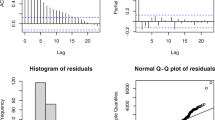Abstract
Detection and clarification of cause-effect relationships among variables is an important problem in time series analysis. Traditional causality inference methods have a salient limitation that the model must be linear and with Gaussian noise. Although additive model regression can effectively infer the nonlinear causal relationships of additive nonlinear time series, it suffers from the limitation that contemporaneous causal relationships of variables must be linear and not always valid to test conditional independence relations. This paper provides a nonparametric method that employs both mutual information and conditional mutual information to identify causal structure of a class of nonlinear time series models, which extends the additive nonlinear times series to nonlinear structural vector autoregressive models. An algorithm is developed to learn the contemporaneous and the lagged causal relationships of variables. Simulations demonstrate the effectiveness of the proposed method.
Similar content being viewed by others
References
Spirtes P, Glymour C, and Scheines R, Causation, Prediction and Search, MIT Press, Cambridge, MA, 2nd edition, 2000.
Pearl J, Causality: Models, Reasoning and Inference, Cambridge University Press, Cambridge, 2000.
Bach F and Jordan M, Learning graphical models for stationary time series, IEEE Transactions on Signal Processing, 2004, 52: 2189–2199.
Xie X, Geng Z, and Zhao Q, Decomposition of structural learning about directed acyclic graphs, Artificial Intelligence, 2006, 170(4): 422–439.
Oxley L, Reale M, and Wilson G, Constructing structural VAR models with conditional independence graphs, Mathematics and Computers in Simulation, 2009, 79: 2910–2916.
Whittaker J, Graphical Models in Applied Multivariate Statistics, Wiley, Chichester, 1990.
Lauritzen S, Graphical Models, Oxford University Press, Oxford, 1996.
Spirtes P and Glymour C, An algorithm for fast recovery of sparse causal graphs, Social Science Computer Review, 1991, 9: 67–72.
Eichler M, Granger causality and path diagrams for multivariate time series, Journal of Econometrics, 2007, 137: 334–353.
Hoover K, Automatic inference of the contemporaneous causal order of a system of equations, Econometric Theory, 2005, 21: 69–77.
Demiralp S and Hoover K, Searching for the Causal Structure of a Vector Autoregression, Oxford Bulletin of Economics and Statistics, 2003, 65: 745–767.
Moneta A, Graphical causal models and VARs: An empirical assessment of the real business cycles hypothesis, Empir Econ, 2008, 35: 275–300.
Voortman M and Druzdzel M, Insensitivity of constraint-based causal discovery algorithms to violations of the assumption of multivariate normality, Proceedings of the Twenty-First International Florida Artificial telligence Research Society Conference (ed. by Wilson D and Grove H), Florida, 2008.
Chu T J and Glymour C, Search for additive nonlinear time series causal models, Journal of Machine Learning Research, 2008, 9: 67–991.
Daub C, Steuer R, Sslbig J, and Kloska S, Estimating mutual information using B-spline functions-an improved similarity measure for analysing gene expression data, BMC Bioinformatics, 2004, 5(1): 118.
Goria M, Leonenko N, Mergel V, and Inverardi P N, A new class of random vector entropy estimators and its applications in testing statistical hypotheses, J. Nonparametr. Stat., 2005, 17: 277–298.
Hall P and Morton S C, On the estimation of entropy, Ann. Inst. Statist. Math, 1993, 45: 69–88.
Marschinski R and Kantz H, Analysing the information flow between financial time series — An improved estimator for transfer entropy, European Physical Journal B, 2002, 30: 275–281.
Grassberger P and Procaccia I, Estimation of Kolmogorov entropy from a chaotic signal, Phys. Rev. A, 1983, 28: 2591–2593.
Prichard D and Theiler J, Generalized redundancies for time series analysis, Physica D, 1995, 84: 476–493.
Olbrich E and Kantz H, Inferring chaotic dynamics from time series: On which length scale determinism becomes visible, Phys. Lett. A, 1997, 45(10): 7058–7064.
Author information
Authors and Affiliations
Corresponding author
Additional information
This research was supported by the National Natural Science Foundation of China under Grant Nos. 60972150 and 10926197.
This paper was recommended for publication by Editor ZOU Guohua.
Rights and permissions
About this article
Cite this article
Wei, Y., Tian, Z. & Xiao, Y. Learning causal graphs of nonlinear structural vector autoregressive model using information theory criteria. J Syst Sci Complex 27, 1213–1226 (2014). https://doi.org/10.1007/s11424-014-1289-8
Received:
Revised:
Published:
Issue Date:
DOI: https://doi.org/10.1007/s11424-014-1289-8




